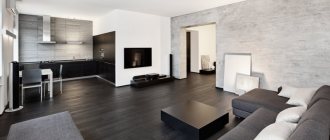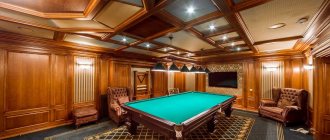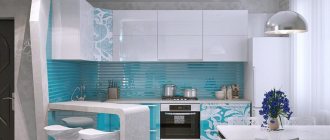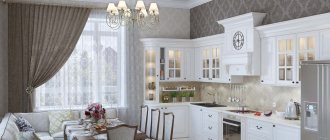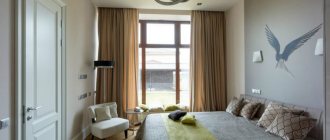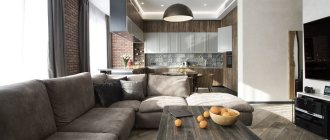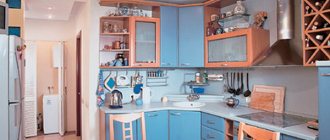Selection of the optimal size
A comfortable position in which a person sits at a table depends on the proper selection, first of all, of its height, standardized in technical regulations. Typically it is in the range of 0.7-0.75 m. For most people, this value provides free space from the knees to the table top.
For sufficient mobility, you can use a higher bar counter, which acts as a table, up to 0.9 m high.
When choosing the dimensions of a table for arranging a dining area, it is advisable to take into account a number of factors:
- area of the dining room or kitchen dining area;
- the number of people gathering for a meal at the same time;
- preferred table shape;
- dimensions and location of the rest of the kitchen furniture..
Capacity is directly proportional to the shape of the tabletop, since the absence of corners in an oval or circle allows you to use the entire surface if you place the chairs close to each other. Innovative delights in giving tables the most unusual shapes are not always profitable and economical, and are sometimes overly cumbersome in visual perception. All kinds of recesses on the tabletops in the shape of flowers, stars, asymmetrical blots limit the number of seats.
How to choose the size of an oval kitchen table?
When deciding on the size of an oval kitchen table, you need to proceed from the free space available to you, as well as from the number of people who will sit at the table every day.
Designers advise that when choosing a full-fledged dining table, pay attention to models wider than 91 cm. Such a table is suitable for placing a sufficient number of dishes and cutlery.
For a comfortable seating arrangement, it is necessary to leave at least an 80-centimeter gap between the table and the wall.
Helpful tip: To visualize how your kitchen table will fit into the space, you can take a sheet or tablecloth that matches the size of the table and place it in the position where you plan to place the table.
In order to choose the correct size of an oval kitchen table depending on the number of seats, use the following table.
| Width(cm) | Length(cm) | Number of seats |
| 75 | up to 100 | 2-4 |
| 75 | 100-154 | 4-6 |
| 91 | 160-180 | 6-8 |
| 109 | 180-240 | 8-10 |
| 140 | 260-300 | 10-14 |
Standard sizes
When making tables, manufacturers use established technical standards, so the sizes are standardized. And at the planning stage of deciding on the future kitchen design, you can accurately predict what sizes of dining tables of different shapes will be the best option.
Round table
In the spacious dining areas it looks chic, reminiscent of patriarchal sketches of a family gathering from different generations under a cozy lampshade over a leisurely conversation during lunch. This configuration provides good visibility without highlighting comfortable seats, creating equal conditions for everyone. But large sizes cause inconvenience because it is difficult to reach the center. If we analyze the standard dimensions, expressed by the diameter size, then the key indicator will be the number of people for whom the product is selected:
- four (0.9-1.1 m);
- five to six (1.1-1.35 m);
- seven to eight (1.3-1.8 m).
Oval table
Attracts with its unusualness. Rounded lines do not limit the dense placement of the maximum possible number of people, but the overly elongated long axis does not allow such a piece of furniture to be placed in small kitchens. The average values have the following ranges:
- four to six people: width – 0.9 m, length – 1.4 m;
- seven-eight: width – 0.9 m, length – 1.8 m;
- nine-ten: width – 0.9 m, length – 2.1 m.
Square table
The square shape is suitable for a small family that does not plan to seat more than four people at the table, for whom such a configuration is comfortable for communication with the length of each side being 0.9-1.1 m. It should be taken into account that such a piece of furniture will not fit into narrow spaces.
Rectangular table
A conservative, familiar configuration of the table, which allows you to increase its functional roles, since in parallel with its usual use as the main item of the dining group, it can divide the kitchen into two zones. It’s easy to choose options for narrow spaces. The sizes available to potential consumers are on average represented by the following lengths with the same standard width of 0.9 m:
- four people: 1.2 m;
- five-six: 1.5 m;
- seven-eight: 1.95 m.
Dimensions and capacity of rectangular and square tables
A rectangular kitchen table is considered the most convenient for everyday use. By choosing a medium-sized model (about 90*150 cm), you will provide comfortable seating for 6-10 people. The ratio of capacity and size here is:
- 150*90 cm – 4-6;
- 200*110 cm – up to 8;
- 260*110 cm – up to 10;
- 320*110 cm – up to 12.
It is also necessary to take into account the area of the kitchen, because it will be convenient to use the dining table only if the chairs can be moved away without problems, and the passage between the dining room and other furniture will be comfortable - it is advisable to maintain this distance of at least 100 cm.
For example, there should be at least 90 cm of free space from the wall to the tabletop, then it will be comfortable to sit here. And if you decide to move the table to the wall with the long side, then four people can comfortably sit behind it, provided that the dimensions of the table top are 80x120 cm. By placing the “rectangle” with the short side, you will get 5 seats, and by moving it to the middle of the room - 6.
Keep in mind that stationary rectangular models are usually quite bulky, and therefore a folding version is better suited for a small room.
Small folding tables from Ikea (pictured below) are very convenient to use.
Perhaps the most compact, but at the same time roomy, table is a square-shaped table. This form is especially relevant for small kitchens, kitchen-living rooms with a dedicated dining area and for small kitchen-dining rooms, since square tables of any size are space-efficient. So, for daily lunches for a family of four, a square measuring 90*90 cm for 4 people is quite enough. The photo below shows square tables in the interiors of small kitchens.
And here is a small square kitchen table in the interior of the living-dining room.
In spacious rooms, a large square table designed for 8 people is appropriate, as in the following photo.
Independent calculation of dimensions
Knowing the approximate norm of the area per person sitting at the table makes it possible to independently calculate the optimal permissible dimensions of a tabletop of a certain shape, which will easily fit into the space allocated for it.
Initial values per consumer:
- width: 0.6 m;
- depth: 0.4 m.
In addition, there should be at least 0.2 m of free space in the center of the table, allowing you to arrange the dishes.
Based on these considerations, the total width of the table is calculated: 0.4 • 2 + 0, 2 = 0.8 m. The perimeter of the rectangle will depend on the estimated number of people planned for regular placement around the table, for example, if there are six of them: P = 0 .6 • 6 = 3.6 m.
The side of the square table will be 3.6: 4 = 0.9 m. Calculating the length of the rectangular analogue, taking into account the ideal width of 0.8 m calculated above, gives the following value: (3.6 - 0.8 • 2) / 2 = 1.0 m. Experts recommend adding another 0.2 m to the calculated value, so the length will be 1.2 m.
For a round tabletop with a diameter of D = 0.8 m, the circumference is calculated and divided by 0.6 m; the resulting result will give the approximate number of people who can comfortably sit behind it for a family dinner: 3.14 • 0.8 / 0.6 ≈ 4 people.
Using this method, it is easy to calculate the ideal diameter of the table for the planned number of people who can sit at it at the same time.
To do this, it is enough to multiply 0.6 (the average width needed for a comfortable position of one person in meters) by the predicted number of people (take, for example, the number of people equal to eight) and divide the resulting result by the number π ≈ 3.14. 0.6 • 8 / 3.14 ≈ 1.53 m – the optimal diameter of a dining table for eight people.
Location
Knowing the exact dimensions of not only the kitchen space, but also the future dining table, which optimally accommodates the required number of people for daily meals together, allows you to develop a scale sketch and select the most rational place for the dining area. The use of space near the window is becoming more and more attractive, but in this case, an oval configuration that is very elongated in length will not be very convenient.
If you still want to avoid sharp corners, then it is advisable to choose a dining table with one stable leg, which allows you to rationally use the space under the tabletop.
Even more comfortable in such situations will be the round surface of the table - a transformer, which without much effort turns into your favorite oval.
When choosing such a conservative shape as a rectangular table, you should analyze the change in capacity depending on its installation. For example, if you take a model with dimensions previously calculated as 0.8 • 1.2 m, then when placed centrally, six people will fit, but if you move the table perpendicular to the wall, then five will be able to sit around it.
With the traditional arrangement close to the wall with the long side, the capacity is reduced to four people. The elegant corner placement of the dining group helps to preserve the full potential of the usable area of the square table.
Dimensions of round and oval table
For a round dining table, a slightly different standard applies:
- Diameter 110 cm – no more than 4 people;
- 130 cm – 6 people;
- 150 cm – 8;
- 170 cm – up to 10.
This option will look traditional and elegant; in addition, the round table has no corners, so it is suitable for families with children. But it has a smaller capacity compared to rectangular designs. However, in this segment you can also choose folding and sliding structures, and transforming tables.
To save space, a round table is placed in a corner and placed closer to the wall.
For small kitchens, semicircular options are more suitable - such as in the following photos:
Oval designs can rightfully be called the most practical - they look more original than rectangular ones and are more convenient to use than round ones.
In addition, there are no sharp corners while fully maintaining the usable area of the tabletop, which ensures safety for families with small children. However, if such a model is longer than one and a half meters, it will still take up quite a lot of free space. In small kitchens, most often oval tables are equipped with a comfortable kitchen corner as in the photo below.
